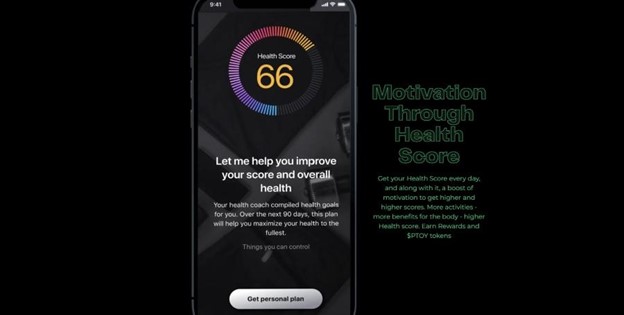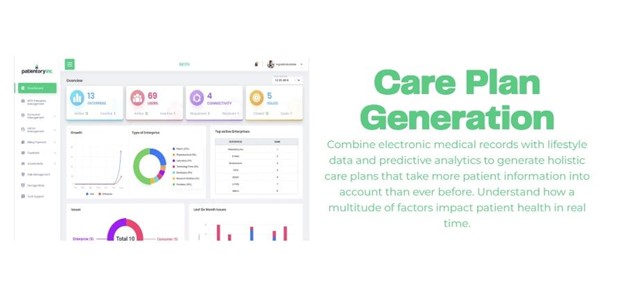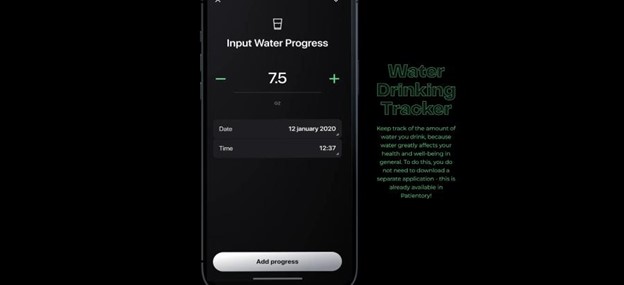
Patientory’s PTOYMATRIX was launched back in December 2020 as one of the world’s first blockchain-focused healthcare solutions. Its aim is to secure and provide easy access to healthcare information for companies building healthcare-specific use cases that require such data. Users have the opportunity to take control of their health information and integrate it with wellness data to generate insights and take better care of themselves.
At the same time, PTOYMATRIX helps healthcare organizations with superior accessibility and management of their patients’ health data. It promises to solve problems around data interoperability, making it easier for medical professionals to access, while also ensuring those records are kept secure through advanced encryption.
Current products built atop of PTOYMATRIX include a consumer health data wallet and enterprise analytics dashboard, which launched publicly in 2023. The app provides benefits such as patients being able to monetize their health data, and enabling the targeted recruitment of individuals for clinical trials.
What follows is a comprehensive review of the Patientory platform that looks at the problems it’s trying to solve and how it fixes them.
What is PTOYMATRIX?
Patientory was founded by its Chief Executive Chrissa McFarlane, who set out to improve healthcare data after becoming disillusioned with the existing, legacy-based system.
The main goal of Patientory’s applications is to create an intuitive way for anyone to be able to access their healthcare information and share it with anyone else who requires it, such as doctors, healthcare providers, and research organizations. To do this, Patientory leverages its native PTOYMATRIX blockchain data storage network. It’s designed specifically to securely store health data with low operational costs. The idea is that storing health data on a blockchain that anyone can access eliminates the need for third-party databases. In Patientory’s vision, hospitals and physicians will no longer need to store their patient’s medical records themselves.
Unlike other blockchains, PTOYMATRIX is not publicly accessible. Access is restricted to qualified healthcare organizations that must sign up as a member of the Patientory Association. Data stored within PTOYMATRIX is encrypted to ensure its confidentiality, with only the owners of that data having control over who can access it. Blockchain technology is unique in its ability to safeguard encrypted data, as all records stored upon it are immutable and unalterable.
Why Do We Need PTOYMATRIX?
The healthcare system is crying out for a better way to store and manage people’s health records. For one thing, the industry has been beset with cyberattacks and data breaches. In 2021, at the height of the coronavirus pandemic, healthcare data breaches hit a record high, impacting more than 45 million people in the U.S. alone and costing the industry an estimated $300 billion. One year later, the number of global cyberattacks increased by 38% – evidence that these malicious actors have no intention of letting up.
So healthcare data currently has a security problem. It also has an access problem, with most people’s health records being siloed within the system of their healthcare provider. This causes all sorts of issues, especially during emergencies. If someone travels to another state on vacation and has an accident, whatever hospital they end up at has no way of accessing their medical records to ascertain if they have any pre-existing conditions. The system is so inefficient that medical records will generally be sent from one hospital to another via fax, and it can often take many hours even for that to happen.
PTOYMATRIX aims to solve these problems, first by improving healthcare data interoperability. By making every patient’s records available in one universal system, they become much easier to access whenever the need arises. The cloud-based PTOYMATRIX blockchain can be accessed from any location while remaining more secure than traditional systems.
Another problem PTOYMATRIX solves is the unfair way that patient data is monetized. In the existing system, healthcare providers are allowed to sell anonymized data to third parties and data brokers. But this never benefits the owner of that data. If healthcare data is to be interoperable, it also needs to be controlled by its owners. PTOYMATRIX’s system provides full transparency into how data is used, with high traceability to ensure it is never misused.
Perhaps the biggest benefit of PTOYMATRIX, however, is that it’s incredibly simple to use. Through its user-friendly interface, PTOYMATRIX provides an easy way for users to quickly view their health data. It simplifies things with an overall “personal health score” that acts as a clear and consistent standard for users to quickly assess how healthy they are, based on their medical records and their lifestyle.
The User-Focused Mobile App

Patientory has created two separate applications to engage with PTOYMATRIX. The first is a mobile, user-oriented platform that combines features such as health history tracking, medical bills, insurance management, vaccination and immunization tracking, and clinical trial management.
The user app is a comprehensive record of each person’s health data, including all of their hospital records, lab test results, and genomic data. It also combines health tracking and progress monitoring features to unearth key insights that people can use to lead healthier lives. These insights include AI-generated predictions, so the app could warn someone if they’re at risk of developing diabetes, for example. It can then provide personalized recommendations for diet, exercises, and treatments to help that person reduce that risk, and then track their progress within the app. Users can even customize their activity schedule based on their interests.
Other capabilities in the mobile app include a medical records management feature. With this, users can build and access a consolidated record of their full health history by tracking their past, present, and future data. They’ll also be able to monetize this data, by opting in to share it with select third parties such as research organizations. Clinical research also benefits from this. By analyzing the user’s medical data, PTOYMATRIX can match users with clinical trials they’re best suited to participate in. As a result, users can help to advance research into new drugs and treatments while being paid for doing so.
Users will earn additional rewards in cryptocurrency simply for interacting with the app. By tracking different activities, such as walking, running, or swimming, users will be able to earn daily points that can later be redeemed for $PTOY tokens, the native cryptocurrency of the PTOYMATRIX blockchain. Finally, users will also be able to save on the cost of their prescriptions, with significant discounts available for those who use Patientory on a daily basis.
The Enterprise-Focused NEITH Platform

Healthcare providers can benefit from using the NEITH Platform in a number of ways. This is a more comprehensive application that taps PTOYMATRIX to provide real-time population health analytics and help medical practitioners speed up their workflows in multiple ways. The main focus of NEITH is analyzing medical data to generate insights that will result in improved health outcomes and physical and mental well-being.
The NEITH Platform integrates with the mobile app, enabling physicians to analyze each patient’s records in a secure, trustless way. By doing this, physicians have the data they need to design carefully-structured and personalized wellness plans for each of their patients.
PTOYMATRIX: A Healthcare-Focused Blockchain
Both apps are connected via the PTOYMatrix blockchain, which is governed by a consortium of its users. The blockchain’s native token $PTOY is used to facilitate data storage and access.
The PTOYMatrix blockchain is a distributed and open network where every transaction is recorded onto a public ledger and timestamped. The data is secured in such a way that only those who have been granted access to the network can view these records. To prevent malicious attacks, each transaction on the PTOYMATRIX chain is verified by blockchain nodes, which earn $PTOY for providing computing power to the network to perform these verifications. In this way, Patientory incentivizes the security of its blockchain. Should a malicious hacker manage to steal any data from it, all they would get is a randomized string of numbers that they’ll never be able to decrypt.
The blockchain is governed by the PTOYMATRIX consortium, which is made up of the network’s users, ensuring no single entity has control over the data stored on it.
Data is organized in a simple way, with each user’s health signified by a personal health score, based on a combination of their medical records and wellness data. This health score and other metrics are used to create a tailored healthcare plan users can follow to try and improve their overall score.
$PTOY: Native Platform Token
PTOYMATRIX users can earn $PTOY tokens simply by using the app regularly and by sharing their data with healthcare providers and other select third parties. In addition, they can also purchase $PTOY tokens directly from cryptocurrency exchange platforms such as BitMart and LBank.
The $PTOY token serves as PTOYMATRIX’s native cryptocurrency and removes the need for any intermediary to manage the user’s healthcare data. It fulfills a number of roles, such as being used for in-app purchases, facilitating interoperability of health records, monetizing unused storage space on blockchain nodes, and enabling smart contracts. $PTOY is also rewarded to users for interacting with PTOYMATRIX.
How PTOYMATRIX Improves Users’ Well-Being

If Patientory is to disrupt a multi-billion dollar industry that’s known for its stiff resistance to change, it’s going to need to provide a multitude of benefits for all parties involved. It’s a job that PTOYMATRIX does well. For instance, it’s the first healthcare app to empower users with full ownership of their health records. By giving people the ability to access their medical data, they can play a stronger role in boosting their own health by following the customized care and fitness plans the app creates. What’s more, PTOYMATRIX provides strong incentives for users to follow these plans, with crypto rewards and, later, non-fungible tokens (NFTs) that will provide further benefits to users.
PTOYMATRIX also provides greater clarity to users by aggregating medical and fitness records in one place, where it can be tapped for insights to create a fuller picture of their health.
Perhaps the biggest selling point of PTOYMATRIX is its strong security. The distributed nature of blockchain makes it almost impervious to hacking. Patientory’s internal research shows that its blockchain is able to reduce data breaches by as much as 85% compared to standard EMR systems.
PTOYMATRIX Has Lots To Offer
The potential of blockchain to transform the healthcare industry has been the subject of numerous blog posts and web articles over the years, but for all of this talk, we’ve seen little progress. PTOYMATRIX stands out as one of the first solutions aiming to make this potential a reality.
Chrissa McFarlane and the team have been working hard for more than eight years now to bring their concept of blockchain-powered healthcare data to life. In that time, they have come up with a highly secure, flexible, and adaptable platform that meets the demand for an easy-to-use and secure health data management system. What’s more, PTOYMATRIX takes interoperability to the next level, facilitating data sharing in a safe way and providing seamless integration with traditional healthcare systems.
Patientory still has a long way to go if it’s to convince a notoriously reticent industry to adopt the PTOYMATRIX platform and become the standard operating system for healthcare data. But by providing a strong incentive to users, together with actionable insights that ensure people can take control of their health, there’s no reason to think it cannot fulfill its vision.


















